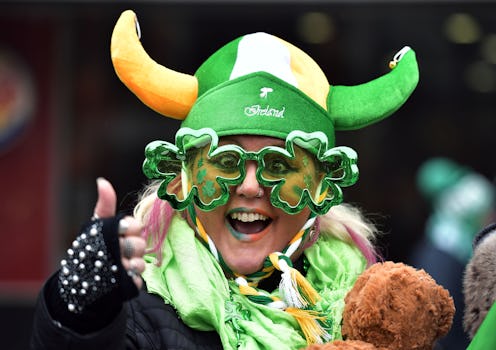Life
7 Things You Never Knew About St. Patrick's Day

You have an all green outfit you wear every year, you stock up on Guinness whenever March comes around, and you're constantly searching for the elusive four leaf clover. Sure, you know a lot of the popular customs associated with the holiday in the United States, but how many St. Patrick's Day facts do you actually know? You might be surprised to find out how different the official holiday is from the way you celebrate each year.
I grew up in the Boston area where almost everyone is Irish, at least a little bit. Girls in my class all had Claddagh rings, boys proudly wore their Notre Dame Fighting Irish apparel, and when March 17 came around, everyone was excited to celebrate their culture's holiday. We'd get decked out in green clothing from head to toe, stuff our faces with soda bread, corned beef, and cabbage, and head to the parades ready to show our Irish pride. The only problem was, none of us actually knew what St. Patrick's Day was really honoring, and so many people still don't know.
As kids, it was an excuse to have a party at school, and as adults, it's an excuse to drink green beer, but what is St. Patrick's Day, really? In case you never figured it out, here are seven facts about St. Patrick's Day you never knew.
1. The Real St. Patrick Wasn't Even Irish
The holiday that, for Americans, is everything Irish isn't even in honor of an Irish person. St. Patrick, the holiday's namesake, was actually born in Britain around A.D. 390. It wasn't until he was kidnapped and sent overseas as a teenager that he stepped foot on the Emerald Isle.
2. St. Patrick Wasn't His Real Name
St. Patrick's Day has a special ring to it, but would you still like it if it was called St. Maewyn's Day? According to history, St. Patrick's birth name was Maewyn Succat. It wasn't until he went to Ireland that he started going by Patricius, which today we know as Patrick.
3. It Was Weather, Not St. Patrick, That Got Rid Of The Snakes In Ireland
A common St. Patrick's Day myth claims that St. Patrick is celebrated for driving all of the snakes out of Ireland, but modern science says otherwise. According to fossil records, there were never any snakes in the country to begin with because Ireland was too cold during the Ice Age for any reptilian life to survive. Now, the freezing ocean surrounding the country keeps the snakes at bay, so you can stop thanking St. Patrick.
4. Modern St. Patrick's Day Is An American Holiday, Not An Irish One
Until the 18th century, St. Patrick's Day was a Roman Catholic feast that was observed only in Ireland. The pubs would close, people would attend church, and there wasn't a green beer in sight. Modern St. Patrick's Day is a product of the Irish immigrants who began organizing the celebration around March 17 as a way to show their pride for their culture. Leave it to Americans to take a holy holiday and make it a drinking one, am I right?
5. 13 Million Pints Of Guinness Are Consumed On March 17
Speaking of beer, over 13 million pints of Guinness will be consumed on St. Patrick's Day. For a holiday that used to be a dry one, things certainly have changed.
6. The First Parade Was In The U.S., Not Ireland
St. Patrick's Day as we know it is a modern American holiday. Because of its roots in this country, over 100 towns and cities from coast to coast host annual parades. The first St. Patrick's Day Parade was held in Boston in 1737, but the largest one has been held in New York City since 1762.
7. St. Patrick's Day Is On March 17 For A Morbid Reason
St. Patrick's Day is on March 17 every year, but why? It turns out the reason is related to death, not life or celebration. March 17 marks the day St. Patrick died, according to legend, which is why we celebrate on that day each year.
Images: Charles McQuillan/Getty Images; Giphy (7)